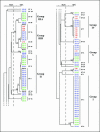Multilocus sequence typing of Candida glabrata reveals geographically enriched clades
- PMID: 14662965
- PMCID: PMC309006
- DOI: 10.1128/JCM.41.12.5709-5717.2003
Multilocus sequence typing of Candida glabrata reveals geographically enriched clades
Abstract
The haploid pathogenic yeast Candida glabrata is the second most common Candida species isolated from cases of bloodstream infection. The clinical relevance of C. glabrata is enhanced by its reduced susceptibility to fluconazole. Despite this, little is known of the epidemiology or population structure of this species. We developed a multilocus sequence typing (MLST) scheme for C. glabrata and used it to fingerprint a geographically diverse collection of 107 clinical isolates and 2 reference strains. Appropriate loci were identified by amplifying and sequencing fragments of the coding regions of 11 C. glabrata genes in 10 unrelated isolates. The 6 most variable loci (FKS, LEU2, NMT1, TRP1, UGP1, and URA3) were sequenced in the collection of 109 isolates. From the 3,345 bp sequenced in each isolate, 81 nucleotide sites were found to be variable. These defined 30 STs among the 109 strains. The technique was validated by comparison with random amplified polymorphic DNA and the complex DNA fingerprinting probes Cg6 and Cg12. MLST identified 5 major clades among the isolates studied. Three of the clades exhibited significant geographical bias. Our data demonstrate for the first time, with such a large geographically diverse strain collection, that distinct genetic clades of C. glabrata prevail in different geographical regions.
Figures



References
-
- Abi-Said, D., E. Anaissie, O. Uzun, I. Raad, H. Pinzcowski, and S. Vartivarian. 1997. The epidemiology of hematogenous candidiasis caused by different Candida species. Clin. Infect. Dis. 24:1122-1128. - PubMed
-
- Csank, C., and K. Haynes. 2000. Candida glabrata displays pseudohyphal growth. FEMS Microbiol. Lett. 189:115-120. - PubMed
Publication types
MeSH terms
Substances
Grants and funding
LinkOut - more resources
Full Text Sources
Other Literature Sources
Research Materials
Miscellaneous

